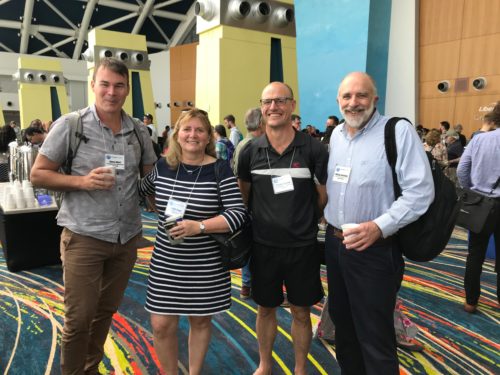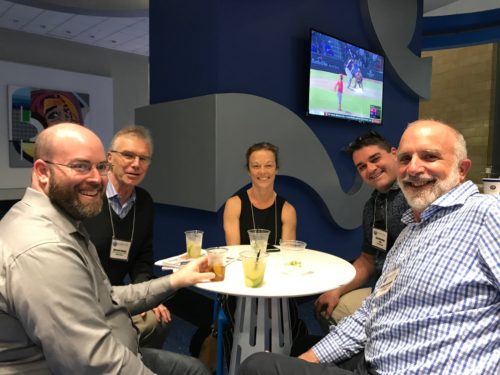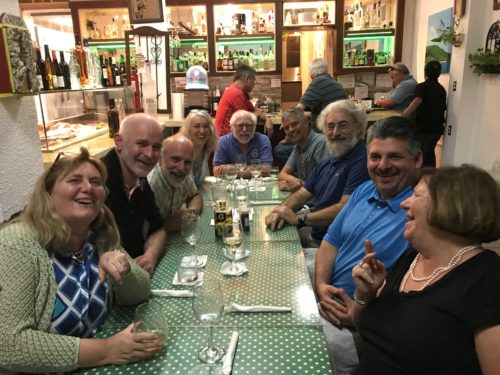Association for Science of Limnology and Oceanography in San Juan, Puerto Rico
Bill Dennison ·
The Association for the Sciences of Limnology and Oceanography (formerly American Society of Limnology and Oceanography; ASLO) held its winter meeting in the San Juan, Puerto Rico convention center. The theme of the conference was “Planet Water: Challenges and Successes”. The session that I contributed to was on “Ecosystem Based Management: Holistic Approaches to Effective Management of Regional Ecosystem”. I likened this session to the junk drawer in everyone’s kitchen, important odds and ends that don’t fit neatly into the other drawers. My talk was titled “Creating and communicating environmental intelligence for Chesapeake Bay research and management”. I told the story of our Submerged Aquatic Vegetation synthesis effort (SAV SYN) in Chesapeake Bay, which was timely in that less than 24 hours before my talk, we learned that our paper in the Proceedings of the National Academy of Science (Lefcheck et al., 2018) had been selected for the Cozzarelli Award.

My biggest takeaway from this conference was the next generation scientists that were well represented. There were many undergraduates, graduate students and junior faculty presenting their research. There were a few ‘vintage’ scientists as well, but the amount of young people dominated. This is very healthy for the field. Their enthusiasm was contagious, but I did note some rediscovery of research that was published two to three decades previously. Two programs that contributed to the undergraduate representation were the Research Experience for Undergraduates (REU) program and the Association for the Sciences of Limnology and Oceanography Multicultural Program (ASLOMP). High school students even attended one of the morning plenaries.
A major theme of the conference was Hurricane Maria, a Category 4 Hurricane that passed directly over Puerto Rico in 2017. I was in San Juan last year to facilitate a workshop on ecological drought, but the workshop and field trip were focused on the years leading up to Hurricane Maria. So it was quite interesting to hear so much about Hurricane Maria. The videos during the hurricane were absolutely frightening, with loud driving rain, trees uprooted, roofs flying through the air and deluges of water running through the streets. The overflight videos immediately following the hurricane were sobering as well. Even though it was about a year and half since the hurricane, the emotions were still raw when people spoke about its impact.

I noticed that drones were being used in many research applications, including my Australian colleagues Simon Albert and Alistair Grinham from the University of Queensland who used drones to semi-quantitatively measure methane release from reservoirs. I also noticed that eDNA is being widely employed to detect the presence of organisms in water bodies. Another technique that is becoming standard is the genetic analysis of organisms being investigated. Blue carbon was also a theme, accounting for the amount of sequestration of atmospheric carbon dioxide by oceanic plants. I also learned about the phenomenon of “ocean darkening” referring to the reduction in light penetration into oceanic waters.
Seagrasses were a theme at this conference, if only because of
the impacts of an introduced seagrass species, Halophila stipulacea into
the Caribbean. H. stipulacea, native to the Mediterranean and Red Seas,
is spreading throughout the Caribbean archipelago, with the concern that it is
replacing the native seagrass species. What I enjoyed the most about this topic
was that I swam every morning in the ocean where I could see 4 species of
seagrass (and green sea turtles eating them) and then within a couple of hours
be in the San Juan Convention Center learning about them.
It has been many years since I have attended an ASLO meeting and I had forgotten how much fun these aquatic scientists are to be around. Debbie Bronk, a Marine Environmental and Estuarine Science (MEES) graduate and currently Director of Bigelow Laboratory for Ocean Sciences and John Downing from Minnesota SeaGrant were the meeting co-chairs and they were a lot of fun. We had live music and even dancing on the veranda during lunch breaks and at the fiesta dinner on the final night. Discovering that the convention center bar made killer mojitos didn’t hurt either. I also attended several fun reunion dinners with groups from Australia, the Maryland REU program and Stony Brook.

We heard from the many ASLO award recipients during plenaries, as
well as some stellar plenary speakers. The conference had plenary sessions on
each of the five days of the conference, a conference feature that I quite
enjoy. The San Juan Convention Center was a spectacular structure, with a third
floor veranda under a high clear roof. The only problem was the degree of air
conditioning which provided a strong contrast to the balmy San Juan weather.

All in all, I was glad to be able to catch up with the state of aquatic sciences, see old friends, promote the Integration and Application Network, and visit Puerto Rico again. Thirty years ago, I co-taught a Marine Ecology course at the University of Puerto Rico’s Mayaguez campus’ marine station at La Parguera, but we made only fleeting visits to San Juan. Spending a week in San Juan allowed me to get a much better sense of this vibrant city and its colorful people.

Lefcheck, JS, RJ Orth, WC Dennison, DJ Wilcox, RR Murphy, J Keisman, C Gurbisz, M Hannam, JB Landry, KA Moore, CJ Patrick, J Testa, DE Weller, RA Batiuk. 2018. Long-term nutrient reductions lead to the unprecedented recovery of a temperate coastal region. Proc. Natl. Acad. Sci
About the author
Bill Dennison

Dr. Bill Dennison is a Professor of Marine Science and Vice President for Science Application at the University of Maryland Center for Environmental Science.